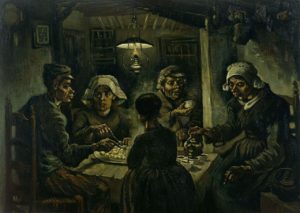Travelling is fabulous for observing and thinking – and there is ample to observe. I thought I would post a few stories that are relevant for ‘creating a place where talent wants to live’. This post is the story about the Van Gogh family and the Van Gogh museum in Amsterdam.
Everyone has heard of Van Gogh, but what fascinated me was how the world nearly missed out on his rich and creative works of art. Four people were required to make this happen: obviously (i) the creator Van Gogh himself, (ii) his financial and emotional supporter Theo (his brother), (iii) his curator and promoter after his death Jo Van Gogh (Theo’s wife) and (iv) his brother’s son Vincent Willem Van Gogh, who worked hard to establish the Van Gogh museum in Amsterdam. Without these four people, there would be no Van Gogh museum today. I thought you might be interested in the challenges each faced and what it tells us about talent.
(i) Van Gogh (the creator)
Vincent helped his brother in collecting and selling art before he decided to become an artist himself. This probably enabled him to develop a good eye. Once he decided to paint, he committed to 12 months of hard work to produce his first art piece. He worked on producing one large canvas, what he called his ‘calling card’. He thought it would bring significant success in the art world, but it largely fell flat. The so-called ‘calling card’ was painted in 1885 and titled ‘The potato eaters’ – see picture attached. It uses a very dark pallet, depicting a real life scene of peasant farmers eating potatoes inside a dark room (nothing like what we know of Van Gogh’s work today). Needless to say the work was not well received and for a large majority of people this would have been the end of any aspirations to become an artist. But instead he worked even harder, producing an enormous amount of art works over a short period of time. He in fact continued in his chosen profession without achieving any critical acclaim in his lifetime.
 Vincent van Gogh – The Potato Eaters 1885
Vincent van Gogh – The Potato Eaters 1885
To use the Institute’s definition of talent (character, personality and skills): Van Gogh showed enormous character to continue his work without recognition, he practiced his skills over and over again, and he continued to work while managing a debilitating mental illness. He was also open to learning from others, trying to retain connections with others through writing letters and inviting artists to join him in the country.
(ii) Theo (the financial and emotional supporter)
Vincent’s brother was not wealthy but was really the only person that provided Vincent financial and emotional support over a long period of time. They were very close but lived a long way from each other. There exists a book of their letters, which I purchased. Van Gogh was also a philosopher and I cannot wait to read his correspondence.
The lesson here of course is to support talent. Supporting talent can be a long-term endeavour. Theo died not long after Vincent, leaving his wife with a young son (who was a year old) and no assets (other than Van Gogh’s paintings).
Vincent was having a very depressing time towards the end of his life but on learning of the arrival of his nephew he painted a picture of the almond tree blossoming and sent it to his brother to mark the happy occasion. The blossoms represented awakening and hope. So many of his other pictures were very dark at this time; he must have been truly happy on the arrival of his nephew. See the famous almond blossom picture below. Almonds are a favourite of mine, I planted three almond trees two years ago but they are yet to blossom. I also make fresh almond milk from soaked nuts most mornings, which I highly recommend.
(iii) Jo (the curator)
Theo died shortly after Vincent, leaving his wife with no assets other than a pile of his brother’s paintings. She must have felt the loss of her husband a great deal, but since she had a young son to feed she had to find a way forward. She worked hard to have Vincent’s work recognised and set about creating the first exhibition of Van Gogh’s work. She was shrewd, being careful to manage his works as a whole, working up a narrative to optimise value, selling when she needed to but not too frequently.
In terms of talent, her careful, considered and calculated approach to building value over time paid dividends both for her son and for Vincent Van Gogh’s broader legacy.
(iv) Vincent Willem Van Gogh (the chronicler)
Vincent’s nephew, the recipient of the almond blossom painting, then picked up the baton and worked hard to create and manage a foundation to build a museum for Van Gogh’s work. He too was successful. There is a picture of him in the museum, with the almond blossom painting in the background – in his 75th year – at the opening of the museum in 1975.
He built on his mother’s hard work – she had curated the work, bringing the pieces together as one narrative, whereas he chronicled the works and worked with philanthropists and city leaders to create a home for them.
This story has stayed with me because it seems so easy to forget about all the things that need to align to build a talent-based economy. Whether we are the creator, the supporter, the curator or the chronicler – there is a role for each and every one of us. To remind me of this, and the need to never give up, I have purchased a postcard of Van Gogh’s potato eaters to sit on my desk when I return to New Zealand.
